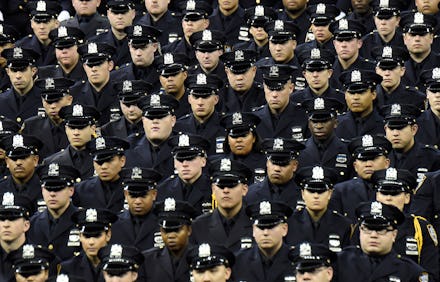Police Deaths by Guns Skyrocketed This Year — But the Larger Trend Tells a Different Story

It's been a dark year for the men and women in blue.
According to a preliminary report released Tuesday by the National Law Enforcement Officers Memorial Fund, police deaths caused by firearms increased by 56% in 2014. Out of 126 officer fatalities this year, 50 of them were gun-related, compared to 2013, when 32 officers were killed from firearm use.
According to a press release, the deadliest states for law enforcement were California, Texas, New York, Florida and Georgia. Ambush-style attacks were the leading cause of deaths for the fifth year in a row, while traffic-related incidents were the second largest cause.
Overall, law enforcement fatalities increased by 24% this year, reversing what NLEOMF described as "two years of dramatic declines in line-of-duty deaths." It is worth noting, however, that despite this year's spike, police deaths have generally been on a downward trend since the 1970s, and this year is consistent with that pattern.
A disturbing trend captured by high-profile shootings. The report comes just days after the high-profile, execution-style killing of New York City police Officers Rafael Ramos and Wenjian Liu. The two men were seated in a patrol car in Brooklyn when the gunman, 28-year-old Ismaaiyl Brinsley, approached them from behind and opened fire.
As Reuters noted, "The shooter who killed the two policemen and then himself had written online that he was avenging the deaths of two unarmed black men last summer in Ferguson, Missouri, and New York."
The attack deepened the rift between the NYPD and Mayor Bill de Blasio, as well as tensions between the police force and the community at large. Many in the police community, including NYPD union president Patrick Lynch, slammed de Blasio for his perceived lack of support of the department.
"That blood on the hands starts on the steps of city hall in the office of the mayor," Lynch said, following the deaths of Ramos and Liu. Hundreds of officers then turned their backs on de Blasio at Ramos' funeral on Dec. 27, prompting Police Commissioner William Bratton to call the behavior "inappropriate."
Beyond the borders of New York City, police officers were recently shot at in both Florida and Los Angeles. The two officers in California were targeted while in a car on Sunday, while a shooter fired three bullets at two deputies with the Pasco County Sheriff's Office in Florida that same morning.
But tensions have been high for quite some time. The deaths of officers Ramos and Liu came just weeks after massive protests in New York and around the country against police brutality. The demonstrations were in response to the deaths of Eric Garner and Michael Brown, two unarmed black men who died at the hands of police officers. Neither officer was charged in the crime.
With respect to both the protests and the officer deaths, the police union declared that the NYPD had become a "wartime" police department, and they will "act accordingly" — something that suggests tension between law enforcement and the rest of the population hasn't come close to settling.
Civilian deaths at the hands of police officers — of which we have regrettably few statistics — are a tragedy. But police deaths can't be ignored, and if NLEOMF's preliminary data is any indication, we have a long road to go in preventing them.
As Steven W. Thrasher at the Guardian writes, "All of this violence is connected. We owe it to those taken from us too early – from young black men in Ferguson and Ohio and beyond, and certainly to those two NYPD cops in their squad car in Brooklyn and their families — to break the American cycle of violence, even when it starts spinning in reverse."